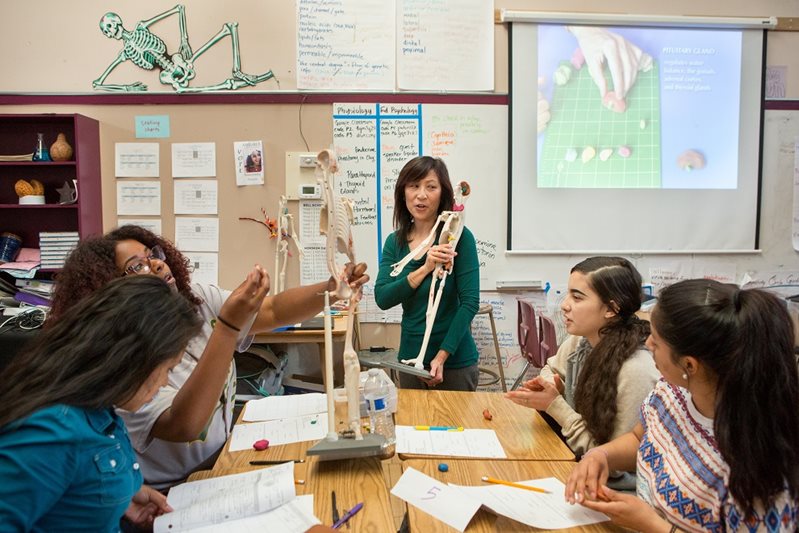STEM Education Unlocks Potential for All Students (The Path Forward)
January 5, 2022
The pandemic made us acutely aware of several things in the education sector. In addition to the inequities laid bare, it forced us to adjust and adapt quickly to function in a new paradigm. Having made it to the other side with varying degrees of success, now we need to address a fundamental question:
What do we need to do to prepare students for college and life, and what tools do educators need to make that a reality?

Transforming the Learning Experience
Technology and engineering jobs are on the rise, but not everyone is suited for that type of work. Why, then, is it essential to make STEM skills available for all students?
Because a science, technology, engineering and math (STEM) education is uniquely suited to prepare students for success.
The STEM approach to education offers students a mindset and skillset valued in any profession. It teaches students to be flexible, detect patterns, find connections, and evaluate information. We can unlock the potential of all students by developing the in-demand, real-world knowledge and skills necessary to thrive in life beyond the classroom.
Just as educators demonstrated their agility throughout the pandemic by quickly increasing their digital capabilities and overcoming unimaginable obstacles, their leadership is crucial to delivering an integrated STEM learning process.
Accelerating Learning Through Equitable Access to Advance STEM Education
For more than ten years, the National Math and Science Initiative has been committed to transforming teaching and learning. Regardless of race, ethnicity, gender, ability or economic status, every student should have access to a meaningful, equitable and inclusive education to help them thrive.
With a focus on partnerships with communities, school leaders, teachers, parents and students, NMSI tailors its program to a school’s need so teachers are empowered to help students reach their full potential. In a recent NMSI webinar, a panel of education leaders shared insights on their efforts to take their students to the next level of learning, with a specific focus on closing the learning gaps due to the pandemic.
Panelists discussed how districts and schools retooled their curricula to boost offerings in engineering and technology and the favorable response of students. In addition, they reinforced the need for and importance of professional development for teachers.
NMSI helps schools and districts invest in their educators to help the system and the students it serves recover from the pandemic and in the long term. The American Rescue Plan Elementary and Secondary School Emergency Relief (ARP ESSER) appropriation of federal relief funds presents a unique opportunity to support educators with expanded professional development opportunities.
Preparing Students for the Fourth Industrial Revolution
The world is moving from an antiquated industrial approach toward one more suitable for today’s digital natives. Known as the Fourth Industrial Revolution, it requires that today’s youth are equipped with the skills, tools and mindsets to leverage technology and collaborate creatively to address global issues.
Employment in STEM occupations is projected to grow by more than eight percent by 2028, with healthcare occupations (which generally require a strong STEM background) projected to grow at an even faster rate. Meanwhile, projections for non-STEM occupations are only estimated to grow five percent.
STEM Provides Significant Value for All Employment and Life
STEM education is not only about feeding students into a STEM career pipeline. It gives students more career flexibility when they hit the workforce and better skills for life. Apart from the core academic knowledge gained with STEM, it offers fine-tuned critical thinking, problem-solving, communication and collaboration as foundational skills. The focus on logical thought processes and problem-solving helps students develop mental habits that will help them succeed in any field.
STEM Creates Social Justice and Equity Pathways
Education is the key to success and upward mobility, especially for disadvantaged students. STEM education doesn’t just better prepare students for employment in STEM careers; it gives every student the resources to succeed in a rapidly changing world. In addition, the STEM education approach can help bridge ethnic, racial and gender gaps; it can remove barriers to ensure all students have access to learning.
STEM encourages the broader participation of underrepresented populations, such as women and minorities, in the STEM workforce. For example, although efforts continue to increase diversity in STEM jobs, Black and Hispanic workers continue to be underrepresented compared with their share of the U.S. workforce. Women have made gains in some STEM areas, especially in health-related and life science fields.
STEM Provides Sustainable Solutions to Global Challenges
While we can’t know the challenges the world will face in the decades to come, there’s no shortage of existing issues. To tackle these matters - climate change, healthcare, food insecurity, clean water and sustainable cities - requires STEM expertise and collaborative problem-solving skills.
Moving Forward
There’s no question that STEM is essential for the future of the country and the world. STEM knowledge unlocks the potential for intentional and impactful innovation to tackle the enormous and complex challenges we face as a global community.
Equipping educators with the skills and tools to tackle learning challenges and create a more equitable education system through professional development can help pave the way to mitigate learning loss and increase student achievement. Working with NMSI will give you the resources you need.